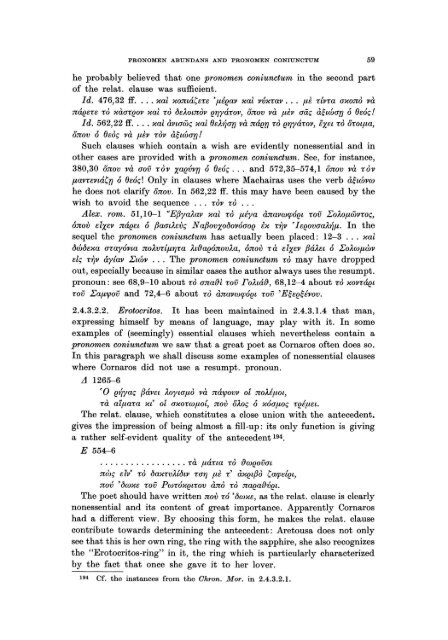Pronomen Abundans and Pronomen Coniunctum. A ... - DWC
Pronomen Abundans and Pronomen Coniunctum. A ... - DWC
Pronomen Abundans and Pronomen Coniunctum. A ... - DWC
You also want an ePaper? Increase the reach of your titles
YUMPU automatically turns print PDFs into web optimized ePapers that Google loves.
PRONOMEN ABUNDANS AND PRONOMEN CONIUNCTUM 59<br />
he probably believed that one pronomen coniunctum in the second part<br />
of the relat. clause was sufficient.<br />
Id. 476,32 fr .... ~a;' ~o:ruáCs'l"B 'fli(!av ~a;' vv~rav ... /û ·dv-ra a~onà và<br />
ná(!s'l"B -rà ~àa-r(!ov ~a;' -rà beAotnàv (!'fJyá-rov, onov và fliv aaç; Muvan ó (Jsóç;!<br />
Id. 562,22 fr .... ~a;' àvtawç; ~a;' (Jûrwn và ná(!n -rà (!'fJyá-rov, exst -rà o-rOtfla,<br />
onov ó (Jsàç; và fliv -ràv Muvan!<br />
Such clauses which contain a wish are evidently nonessential <strong>and</strong> in<br />
other cases are provided with a pronomen coniunctum. See, for instance,<br />
380,30 onov và aov -ràv Xa(!V'JIn Ó (Jsóç; ... <strong>and</strong> 572,35-574,1 onov và -ràv<br />
flav'l"BvtáCn Ó (Jsóç;! Only in clauses where Machairas uses the verb à~uf)'JIw<br />
he does not clarify onov. In 562,22 fr. this may have been caused by the<br />
wish to avoid the sequence ... -ràv -rà ...<br />
Alex. rom. 51,10-1 "EfJyaÀav ~a;' -rà fliya ànavwepó(!t TOf} EoÀOflwv-roÇ;,<br />
ónov elxsv ná(!ét ó fJaatAsvç; N afJovxoCJovóao(! è~ -r~'JI 'I s(!OVaaÀ~fl. In the<br />
sequel the pronomen coniunctum has actually been placed: 12-3 ... ~a;'<br />
CJwCJs~a arayóvta nOÀv-rtfl'fJra ÀdJa(!ónovÀa, ónov Tà elXS'JI fJáÀét ó EOÀwflWV<br />
elç; -r~v áy{a'JI Etwv ... The pronomen coniunctum -rà may have dropped<br />
out, especially because in similar cases the author always uses the resumpt.<br />
pronoun: see 68,9-10 about Tà ana{}l Tof} rOÀtáfJ, 68,12-4 about Tà loCOVTá(!t<br />
TOf} Eafltpof} <strong>and</strong> 72,4-6 about -rà àna'JIwepó(!t -rof} , E~s(!Uvov.<br />
2.4.3.2.2. Erotocrito8. It has been maintained in 2.4.3.1.4 that man,<br />
expressing himself by means of language, may play with it. In some<br />
examples of (seemingly) essential clauses which nevertheless contain a<br />
pronomen coniunctum we saw that a great poet as Cornaros of ten does so.<br />
In this paragraph we shall discuss some examples of nonessential clauses<br />
where Cornaros did not use a resumpt. pronoun.<br />
L1 1265-6<br />
'0 (!~yaç; fJávét Àoytaflà và nátpovv Ot noÀiflot,<br />
-rà a'lflaTa loCt' ot aloCoTwflo{, nov oÀoç; ó ~óafloç; -r(!iflSt.<br />
The relat. clause, which constitutes a close union with the antecedent.<br />
gives the impression of being al most a fill-up: its only function is giving<br />
a rather self-evident quality of the antecedent 194.<br />
E 554-6<br />
................. Tà flána -rà fJW(!of}at<br />
nwç; elv' Tà CJa~-rv).{CJt'JI<br />
-ra'fJ fli -r' àloC(!tfJà Caepet(!t,<br />
nov ' CJw~s TOf} Pw-ró~(!t-rov ànà -rà na(!afJv(!t.<br />
The poet should have written nov TÓ 'CJWloCS, as the relat. clause is clearly<br />
nonessential <strong>and</strong> its content of great importance. Apparently Cornaros<br />
had a different view. By choosing this form, he makes the relat. clause<br />
contribute towards determining the antecedent: Aretousa does not only<br />
see that this is her own ring, the ring with the sapphire, she also recognizes<br />
the "Erotocritos-ring" in it, the ring which is particularly characterized<br />
by the fa ct that once she gave it to her lover.<br />
194 Cf. the instanees from the Ohron. Mor. in 2.4.3.2.1.
















